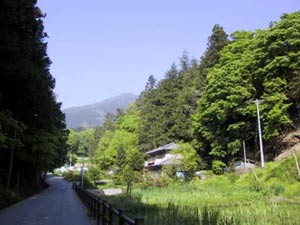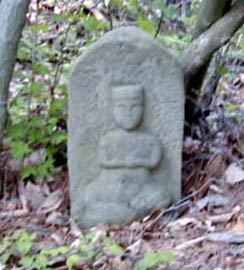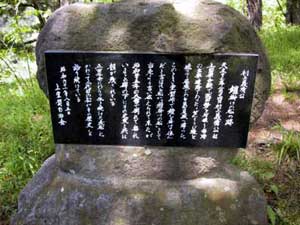

Muroga-Mura
Muroga-mura – “the Muroga Area” – lies in the
mountainous area to the south of Nagano City, just within the northwestern
border of Ueda City limits. Artifacts from the Jomon Era (13,000 BC-300
BC) and Yayoi Era (300 BC-300 AD) have been discovered in this region,
attesting to its settlement in prehistoric times.
Gateway to Nagano
Over time, the area around Ueda City became an important thoroughfare
for land traffic through central Japan, and pilgrims, soldiers, and traders
traversed this mountainous area through Muroga Pass.
 In
642, Zenkoji Temple was constructed in Nagano City in order to house a
famous Buddhist image, of Amida Buddha standing together with two boddhisattvas
under one halo, believed to be the first Buddhist image to arrive in Japan
and credited with miraculous powers. Thus beginning in the 7th century,
pilgrims from across Japan have been travelling through Muroga-mura to
Zenkoji to view a copy of the Amida image. The original is never displayed.
In
642, Zenkoji Temple was constructed in Nagano City in order to house a
famous Buddhist image, of Amida Buddha standing together with two boddhisattvas
under one halo, believed to be the first Buddhist image to arrive in Japan
and credited with miraculous powers. Thus beginning in the 7th century,
pilgrims from across Japan have been travelling through Muroga-mura to
Zenkoji to view a copy of the Amida image. The original is never displayed.
During the 12the century, central Japan became subject to competing rulers,
and armies marching northward began crossing through the region as well.
Strategically important to the Kamakura regime, whose rule extended from
the Kanto plain to the east to the Kansai area to the west, were the Tokaido
Road, the main road crossing Japan from east to west, and the mountainous
northern region in the Nagano area, whose rugged terrain separated interior
Japan from the Japan Sea, and whose mountain roads provided access to
the region.
Moreover, the salt trade was very important in early times, thus traders
passed through the area, and armies protected the transport of this valuable
product from the Japan Sea to their homelands.
Muroga Pass
In such a mountainous region, rivers and riverbanks would be natural travel
routes, and the Chikumagawa is a large river flowing northward to Nagano
City and the Japan Sea. However, while the eastern bank of the Chikumagawa
is easily followed along its length, because of its steep banks, the western
bank becomes impassable  south
of Nagano City. It is impossible to cross over to the eastern side by
boat, as at this point the main river fans out into numerous tributaries
that flow alongside of it, and bridging the expanse would be impractical
because the numerous bridges needed would doubtless be washed away in
the river’s frequent flooding.
south
of Nagano City. It is impossible to cross over to the eastern side by
boat, as at this point the main river fans out into numerous tributaries
that flow alongside of it, and bridging the expanse would be impractical
because the numerous bridges needed would doubtless be washed away in
the river’s frequent flooding.
However, travelers from the west could avoid the treacherous part of the
western bank by crossing over the mountains through Muroga Pass and then
following a winding road that descends through the area of Sakiki township
and leads to the Chikumagawa, whose western bank at this point is fairly
level all the way to Nagano City, 30 km to the north.
Settlement & Development
Muroga-mura’s early population would have consisted of a mixture
of farmers and samurai. Farmers would be such crops as rice, wheat, barley,
millet, and beans, while the samurai would be engaged in training, fighting,
and performing administrative activities.
Nowadays, farming is still an important occupation in Muroga-mura. In
particular, rice, soba (buckwheat), and vegetables are common crops. Vegetables
from Muroga-mura are famous in Japan for their good taste, which can be
attributed to the mountain climate which has significant temperature variation
and a short growing season. In particular, lettuce from Muroga-mura is
renowned for its sweetness.
However, farming is no longer a main occupation for most Muroga-mura residents.
Most of the family farms in the area are too small to be able to support
a family’s livelihood, so those who farm have professional jobs
as well, typically working at small factories or manufacturing companies
in the area, or in Ueda City.
Present-day Muroga-mura consists mainly of  homes,
family farms, and some small-scale industries. It is divided into two
townships; Kami Muroga (Upper Muroga) to the north, where most of the
important historic sites are located, and Shimo Muroga (Lower Muroga),
to the south.
homes,
family farms, and some small-scale industries. It is divided into two
townships; Kami Muroga (Upper Muroga) to the north, where most of the
important historic sites are located, and Shimo Muroga (Lower Muroga),
to the south.
Recently, a spa facility, Muroga Onsen, is under development. Its modern
bathing facilities incorporate the area’s natural spring water containing
a rich mix  of
of
healthy minerals. There are plans to develop the Onsen area for tourism
as well that include constructing a walking path to the ruins of Muroga
Castle, as well as designing walking or driving tours marked by signs
explaining the historical significance of specific places of interest.
Muroga Pass remained an extremely important travel route until a hundred
or so years ago, by which time improvements in road construction technology
enabled a narrow road to be chiseled through the Chikumagawa’s western
cliffs. The north-south railway line running through Nagano Prefecture
follows the Chikumagawa’s gentler eastern bank.
Settlement of the Muroga Clan
Muroga-mura is named for the Muroga clan. The Murogas were originally
members of the Ina Genji clan who adopted ‘Muroga’ as their
new clan name when they were sent by the Kamakura government to establish
residence in and defend this area in the mid-13th century. The Ina Genji,
descendants off the Emperor Seiwa, were originally from the Ina area,
in the southwestern part of present-day Nagano Prefecture.
The Kamakura government, based in Kamakura south of present-day Tokyo,
ruled from 1180-1333, controlling most of the developed parts of Japan.
At that time, the  imperial
family resided in Kyoto, but was virtually powerless Following the counsel
of Yasutoki Hojo (1183-1242), a powerful adviser to the shoguns, the Kamakura
government set up an extension of Kamakura rule at Bessho Onsen, south
of Muroga-mura. Bessho Onsen lay 4 km to the west of the mountainous area
called Shiota, whose defense were key to military control of the region.
Many small castles on dirt mounds and surrounded by dry moats built by
local war lords dotted the mountains in Kamakura times. Warlords and other
citizens enjoyed bathing in the natural spring waters at Bessho Onsen,
and a pagoda and shrine were constructed as the town became more developed.
imperial
family resided in Kyoto, but was virtually powerless Following the counsel
of Yasutoki Hojo (1183-1242), a powerful adviser to the shoguns, the Kamakura
government set up an extension of Kamakura rule at Bessho Onsen, south
of Muroga-mura. Bessho Onsen lay 4 km to the west of the mountainous area
called Shiota, whose defense were key to military control of the region.
Many small castles on dirt mounds and surrounded by dry moats built by
local war lords dotted the mountains in Kamakura times. Warlords and other
citizens enjoyed bathing in the natural spring waters at Bessho Onsen,
and a pagoda and shrine were constructed as the town became more developed.
Meanwhile, Muroga Pass held military significance as well: It was a gateway
to northern Nagano approached from the west, and control of northern Nagano
was key to control of the Japan Sea. Thus, around 1247, Jiro Hayashi of
the Ina Genji clan was dispatched to establish Kamakura rule in the area
that became known as Muroga-mura.
After their relocation, Hayashi and his followers adopted the name ‘Muroga’.
The original meaning of the Chinese character ‘muro’ ¼¼ is
‘food storage,’ but over time it took on the more general
meaning of ‘valley,’ as food was commonly stored in mountainsides.
The variant ‘moro’ ½ô is found in the place name Komoro ¾®½ô, a city east of Muroga-mura. The Chinese character ‘ga’ 賀 means ‘celebration’ or ‘happiness.’ The surname Muroga is rare. There are currently only about 2000 families with this family name living in Japan, and a few Muroga families living abroad. All Murogas can trace their roots to Muroga-mura.
Castles of Muroga-Mura
The ruins of five castles can be found in Muroga-mura. The earliest castle
is Atobe Castle, dating from the time of Kamakura rule before the arrival
of the Muroga clan. This small castle would have served as a watch castle.
A historic house known as O-yashiki stood near this castle. The other
four castles were constructed by Murogas for their military needs.
The first Muroga castle was probably Takauchi Castle (Hunting Hawk Castle).
Strategically located at a T-intersection near a roadway entering Muroga-mura
from the east, this castle would have provided a good vantage point for
keeping watch over the surrounding territory. In time, this castle was
abandoned, perhaps because of its proximity to the Koizumi lands to the
east, as the Koizumis were brothers rather than enemies of the Murogas.
 The
other three Muroga castles were built nearer to the center of Muroga-mura.
Harahata Castle stood on a central plain, while Sasabora Castle, a small
castle that has come to be known as Muroga Castle, stood on an overlooking
mountain.
The
other three Muroga castles were built nearer to the center of Muroga-mura.
Harahata Castle stood on a central plain, while Sasabora Castle, a small
castle that has come to be known as Muroga Castle, stood on an overlooking
mountain.
Isezaki Castle, built about 500 years ago, is a small castle that, like
Atobe Castle, probably served as a watch castle. As Isezaki Castle stood
at a relatively high elevation, soldiers of the castle would be well positioned
to keep watch and observe battles. Moreover, defenders could rapidly sweep
down from its heights and gain the advantage over surprised enemies.
As smoke signals were an important means of conveying information at that
time, soldiers from Isezaki Castle could send and keep watch for them.
Quite a few mountains lie between Muroga-mura and the Yamanashi region,
a stronghold of the Takeda family, who were first adversaries, but later
allies of the Muroga family. Watchers could also look out for fires and
wildfires from this height.
Japanese castles were sometimes protected by water-filled or dry moats.
However, as water-filled moats require a continuous water supply, and
the flow of the Hizawa River and nearby waterways varied seasonally, castle
moats in Muroga-mura were all dry moats. The remains of dug-earth ditches
that served as defensive dry moats can be found near Harahata and Muroga
castles.
Temples and Shrines
It was typical of Japan in earlier times as it is today that the traditions
of different  religions
or belief systems coexisted. Shinto shrines, Buddhist temples, and religious
monuments associated with a range of beliefs and superstitions, or their
remains, can be found in Muroga-mura.
religions
or belief systems coexisted. Shinto shrines, Buddhist temples, and religious
monuments associated with a range of beliefs and superstitions, or their
remains, can be found in Muroga-mura.
Zensho-ji is one of the main Buddhist temples in Muroga-mura. Over the
years, several small area temples were absorbed by it. One such temple
was Gokoku-in, whose remains lie about 400 meters distant. When it was
a working temple, it was famous for the long and earnest prayers of its
twelve devout priests.
Another Buddhist temple in the area is Dainichi-do, constructed in 1691.
This is a small temple that had no priest in residence. Another small
Buddhist temple of Muroga-mura is Kannon-do. There are now only the remains
of Jinpuku-ji and Bishamon-do temples, as well as of Juo-do Temple, that
commemorated 10 important disciples of Buddha.
Many stone monuments of Buddhist deities can be found in different parts
of Muroga-mura. For example, at Shirosaka Slope stand ten statues of disciples
of Buddha believed to guard travelers, who pray to these statues for protection
against traffic accidents. Statues of gods representing ancestors have
also been erected along roadsides, that are believed to guide travelers
safely down the road.
The Roku-jizo are six statues representing Buddhist images considered
to possess the ability to cure six different bad character tendencies,
including covetousness and improper thinking.
Hibuse-jizo is a statue of a Buddhist image cut into stone believed to
have the magical ability to stop fire. There is a legend that long ago
a wildfire on the mountain stopped just as it came close to that carving. Several Shinto shrines can also be found in Muroga-mura. An important
shrine complex is the Hizawa main shrine and its inner shrine, Okusha,
that is mounted on a steep stone wall. The Minakami Shrine and the remains
of Kutsugata-myojin Shrine can also be found in Muroga-mura.
Hanaushi-myojin Shrine is associated with an interesting local legend
explaining how the Nishizawa family came to settle in Muroga-mura. According
to the legend, the Nishizawas were traveling through the area when the
ox pulling their cart dropped dead of exhaustion and turned to stone.
This was interpreted as a sign that their journey to find a new home had
ended. A stone statue of an ox complete with shoes, harness, and saddle
stands within the shrine commemorating this event. After the Murogas,
the Nishizawas were the main family group settling in Muroga-mura. Now
Nishizawa is a common surname in Muroga-mura, while the Murogas have mainly
moved more toward the center of Ueda City.
The Seishi-son harvest festival monument, connected with Shinto traditions,
marks the site where youth of the village used to pray for a good harvest
as they waited for the moon to rise on the 23rd day after the first full
moon of the harvest month, that is, October on the lunar calendar. On
this day, a harvest festival would be held, a joyous occasion when the
villagers would feast and dance to celebrate the year’s harvest.
Visitors seeking success in finding a good marriage partner would pray
at the Goizuka monument. Such matchmaking monuments are common in the
Nagano area
.
The Koshin-to stones depict the twelve animal signs of the traditional
Chinese zodiac combined with the ten traditional signs for natural phenomena;
water, fire, and so forth, arranged to represent their cyclical relationship.
There is the belief that on certain nights specified by the zodiac, bad
worms escape from people’s bodies and confess the improprieties
of their hosts. So, people do not sleep during these nights. However,
the Koshin-to stones are believed to have the power to prevent the escape
of such worms.
Historic Roadways
The roadways in Muroga-mura have always been of great importance, not
only for their strategic significance and because they are the route northward
to Nagano City, but also because good roads are essential for any mountainous
region. All of the historical road markers in Muroga-mura point out the
direction to Zenkoji Temple.
The Nishimatsuo road crossed through the southwestern part of Muroga-mura
and Takeda forces sometimes invaded the area from the south or west using
this road. The southwest border of Muroga-mura is marked by a mound of
earth called Bushi-zuka.
The Otebashi Bridge, located near the center of Kami Muroga, crossed the
Hizawa River.
Sakura Horse Training Grounds
Horses were an integral part of samurai warfare during feudal times, even
in mountainous regions like Nagano. The ruins of the Sakura horse training
ground can be found on the plain to the east of Harahata Castle.
Shoshida Rice Fields
A collection of rice fields that lie at the eastern edge of Muroga-mura
are called the Shoshida rice fields. The reference to ‘illegitimate
children’ (shoshida) goes back to a local village story. It is said
that that some of these tambo (wet-rice) fields were presented to the
illegitimate son of a village chief and a local girl as a means to ensure
the boy’s livelihood. Later, these rice fields were presented to
and farmed by the twelve priests of Gokoku-in Temple, who used some of
their harvest to make oil for Zenkoji temple.
Commemoritive Military Sites
In the mountains surrounding Muroga Pass lies the Hyogi-daira plain, a
small plateau perched on a mountain ridge, well positioned for observing
fighting below. It is said that Yoshikiyo Murakami discussed Murakami
battle strategies against the Takeda forces as he surveyed the situation from
this plain.
strategies against the Takeda forces as he surveyed the situation from
this plain.
A stone monument has been erected near Muroga Pass that marks the site
where a pine tree stood before the 16th century. It is believed that Yoshikiyo
Murakami hung his armor from this tree as he rested after ascending the
steep approach to Muroga Pass following a Murakami victory over the Takedas.
Okura Warehouses
The Okura warehouses were used to keep rice in reserve for hard times.
They are located in the center of town. Community meetings were sometimes
held in the warehouse area.
Shonara-Dayu Hermitage
Shonara-dayu was a mountain hermit who made his home in Muroga-mura during
the late 19th century. The remains of his habitation can be found in the
mountains, at some distance from the central settlement areas. In feudal
Japan, charismatic shamans (ubasoku) and mountain priests (yamabushi)
associated with superstitions and cultlike beliefs were not uncommon.
Shonara-dayu is remembered as a typical forest recluse who subsisted on
tree bark and other simple forest foods.
Graveyard of the Murogas
The graveyard of the Murogas is also located in Muroga-mura, but this
cemetery was not established until some time after the early days of Muroga
settlement. Thus historic Muroga tombs can be found in different parts
of Muroga-mura. Masatomo Muroga, a former governor of the Sado Island
goldmine during the Tokugawa period, requested that he be buried in Muroga-mura,
and his funerary monument can be found in this graveyard.




